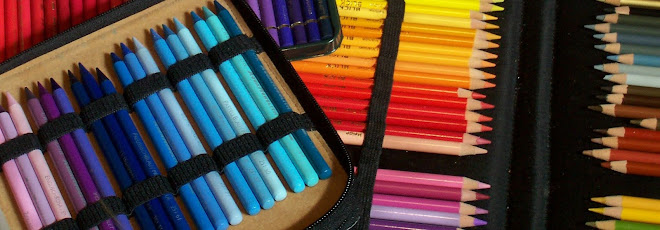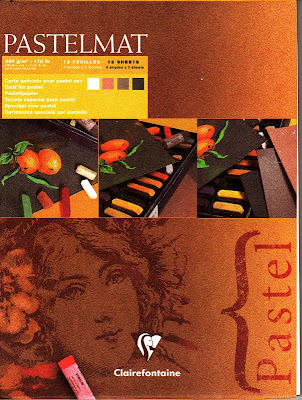
Sakura Pigma Micron pens are the best disposable technical pens I have ever had the pleasure of using. I'm not kidding in the title! This review has a giveaway. See the pretty set of six pens in different widths? It can be yours. Sakura sent me a set to review and an extra set to give away on this blog!
So... you probably want to know how to win it, right?
Comment on this entry! Yep, that's all you need to do. Just post a comment here and tell me that you want the pens. On May 1st, 2010, I will jot down all the names in the comments and write them on little slips to put into her dad's hat, then get my six year old granddaughter, who probably doesn't know you and can't be bribed, to pull one of the names from the hat.
I will announce the lucky winner here on May 1st, and if I don't have your email then I'll post instructions for how you can message me either on Facebook or my oil pastels site, to get your email and snail address without posting it for the whole world to see. You do not need to pay shipping on your pens, I'll mail them when I have your address.
So read on to find out why you want the pens.
Let's see. If you ever write or draw anything, you want these pens. Especially if you hate seeing notes get smeared by coffee spilling on them or dislike having the linework on your manga or comics page or ink and wash painting blurred by the watercolor dissolving it. Pigma Micron pens are waterproof.
Oh yeah. You might want your art to last too. They are very, very archival. I didn't even realize how archival they were until I read the literature Sakura sent with the sample set.
You can store the notes you write with them under water or in a jar full of alcohol, which is what scientists and museum curators do with them. The size 005 gives a teeny tiny thin line allowing you to put four lines of carefully lettered text on a 3/8" wide label and stick it in the jar with the bug. The people who find your bug in the back cabinets fifty years later and realize something about it that should've made you famous will still be able to read your label!
Moral of the story: sign your notes and artwork. With these pens, so that there's no question about who actually did that. Your descendants will know you existed, especially if you use good archival paper.
Decades ago when I was a little kid, I learned to draw and write using Rapidograph technical pens. They are expensive, come in a wide range of nib sizes and they will not tolerate careless use. I have destroyed dozens of the things by leaving ink in them and then not drawing again for a few days, weeks or months. Occasionally I found old pens that I hadn't done anything with in years, inevitably clogged solid and sometimes permanently damaged with the little wire broken or bent.
Then in the 1980s when I ruined an entire set of seven, I got disgusted with Rapidographs and looked for something else that'd give me a waterproof, clean, smooth, super fine line that I could draw things the size of a postage stamp with. I tried a Pigma Micron pen in size 005, which is comparable to about a 00 or 000 Rapidograph. Very fine clean line just at the borderline of what'll show up on a scan. It's too fine a line to run through a normal copier, or was back then.
I was overjoyed to find that the Pigma Micron line was just as clean and perfect. When I'm doing a fine line, I do not want thicker-and-thinner expressive lines. I'll use a dip pen if I want that, or a fountain pen, or a brush tip pen. When I'm doing technical drawings I want to have a line that stays precise, regular and smooth with no skips and will not dissolve if it has liquid washed over it.
I was delighted with that Pigma Micron but reserved my judgment. After all, it wasn't a permanent investment. It wouldn't last forever and might not last very long. The only thing I weighed against its being disposable was that functionally, when I abandoned ink-filled Rapidographs to dry out, I was treating "permanent" pens that I could frugally refill with ink as disposable and replacing them way too fast. Replacing the whole pen seemed wasteful...
Until I found out how long these pens last.
I went through years of filling journals with hundreds of pages of very small handwriting and densely shaded ink drawings. I did large ones and lots of them. I bought all six sizes in Pigma Micron pens to have the entire size range handy, just like with Rapidographs, and discovered another benefit. Filling in the big spaces with the fat size 8 or size 5 Pigma Microns left less of the track marks/tide lines, whatever you call it when filling in something with solid ink makes a texture darker where the lines overlap. Anything I filled in black was black.
And still they wouldn't run out.
It was several years before I first used up a size 01 Pigma Micron, which had become my check-signing, note-jotting, journaling and general scribbling pen. I had bought several to have a fresh one in case I wore out the size I used most, but it still took ages to wear it out. Then I went through a lot of moves.
I wound up opening boxes from three or four moves back, finding stuff I thought I'd lost forever and old Pigma Micron pens with the lettering worn off the barrel by how much hard use they had. Tested them and the dang things still wrote and drew clean lines. I have never, ever found a stored Rapidograph in that condition, or ballpoint, or normal felt tip. If they wind up in the bottom of moving boxes, most pens can just get tossed without testing because they'll dry out.
Pigma Microns don't dry out like that. Okay, I did get in a good habit about capping them after use and tend not to lose caps. But I have sometimes left one open on the drawing table overnight and found it functional in the morning, which has never happened with a Rapidograph. I had finally found something better than Rapidographs for inking!
Sakura Pigma Microns are the very best disposable technical pen I have ever had the joy of handling. I use them for everything from writing checks to drawing fine art. Because they do not die until the very last ink reserves are gone, they are a frugal choice -- they last a lot longer than those cheap ballpoints and felt tips from the dollar store and they'll always give a good controllable line in a great variety of standard widths useful for anything you want to vary pen width on.
You can get a thinner line with a 6x0 Rapidograph, if you really want one. But I would recommend hiring an art student as a butler to fill it, bring it to you when you need those details, then carry it away when you're done, empty it, clean it and put it back in the safe. Even then, be prepared to replace points for $15 to $25 depending on where you buy them at regular intervals, and don't expect to be able to reproduce what you drew or wrote with it.
The fine line of a size 005 Pigma Micron is good enough for miniatures work and you can reproduce it using a high resolution scan. I haven't missed the 6x0 one enough to replace it.
I used to think these only came in black, but there are 14 other colors available! Not all of the colors are available in all sizes, but right now I'm looking for an online source to get the full range of colors. Now I want the assorted colors set and the Sepia set and as many sizes of colored ones as I can get my hands on, since I've begun using colored pens with watercolor in some pen and wash paintings. I know when I get the colored ones that they'll last and last just like the black ones, though of course if I get some that don't, I'll post about it. The size all the colors come in is size 05, which is a pretty broad point, but there's still a good selection in size 005 and size 01, the sizes I use most.
The colors include some old favorites and one that happily surprised me -- yellow. The yellow is only in the size 05 like some of the other colors, but being able to include a yellow detail in a drawing is important to me. I was out on Mt. Petit Jean sketching last year and saw a brilliant yellow flowering bush that I wound up having to include by scribbling with a highlighter. Less of a problem if I've got the yellow Pigma Micron with me.
These are great for plein air. They function in low pressure -- I've used them on planes and when I lived in Colorado they gave me no trouble. They've worked when I was stuck in Minnesota during the worst part of winter and the heat cut out. They've worked in Texas or New Orleans when it gets hot. Nothing seems to stop them.
There's also a Pigma Brush pen with the same pigmented, extremely archival ink. Interesting points from the literature: Sakura uses single pigments to create their ink so as to avoid pigment separation. So if you want a rainbow wash to come from pouring thinner or water over a fresh line on a blotter, you'll need to use normal bottled India ink to get that. It can be a cool effect, but I'd much rather put that in with a dip pen than have it happen accidentally in my pen and wash paintings!
So now you know why you want these good pens. They rock. If you're not the lucky winner, you can find them pretty much anywhere online or offline -- office supply stores, hobby shops, art supply stores. Blick has them at very good prices.
Okay, I amend this. I'll be getting the color ones on my next Blick order because Blick does carry them now! There's a 16 pen Assorted Colors set and a 16 pen all-black set that includes the brush nib and Graphic pens in 1mm, 2mm and 3mm sizes -- extra super-wide Pigma Microns! Definitely a necessity. I can see I'll be changing my plans for May.
One of you will get this great six pen set pictured at the top... so be sure to comment and tell me that you want it!
Here's a pen and wash artwork I did recently with Pigma Microns and watercolor -- including some very soggy washes right over the lines. Notice how clean the lines are and how easy it is to get an expressive line. I should also mention here that even if I vary my pressure or press too hard, it's so hard to kill the points on these that I have only ever done it once. They are made to last and designed for the careless!

Backyard Tree and Shells Page
5" x 8 1/2"
Sakura Pigma Micron pen and watercolor in Moleskine watercolor journal, from life.







